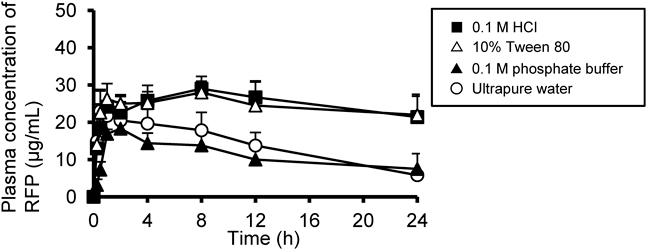Abstract
Rifampicin (RFP; 30 mg/kg) was orally administered to fasted or fed rats using ultrapure water as the vehicle, and the influence of food on its pharmacokinetics was investigated. To examine the influence of intragastric pH and RFP solubility, similar experiments were performed using 0.1 M HCl (pH 1.0), 0.1 M phosphate buffer (pH 6.8), or 10% Tween 80 vehicles. Plasma RFP concentrations were measured by HPLC-UV for 24 h. The administration of RFP to fed rats in ultrapure water (10% dissolved) resulted in a significant 40% reduction in the maximum plasma drug concentration (Cmax) and area under the concentration–time curve (AUC0–24), as compared with fasted rats (p<0.05). RFP administration in 0.1 M phosphate buffer (10% dissolved) produced approximately 25% lower Cmax and AUC0–24 values, as compared with those achieved by RFP in ultrapure water in fasted rats. The administration of RFP in 0.1 M HCl (100% dissolved) to fasted rats increased the AUC0–24 by approximately 1.8-fold, compared with ultrapure water, suggesting that increasing RFP solubility increased its absorption. The 10% Tween 80 vehicles (60% dissolved) enhanced the absorption of RFP to a similar level as observed when using 0.1 M HCl solution, suggesting that both the improvement in solubility and P-glycoprotein inhibition by Tween 80 increased the absorption. This study suggested that RFP solubility in gastrointestinal fluid may be an important determinant of absorption and that it would be beneficial to change the timing of RFP administration to patients with insufficient clinical outcomes by administration after a meal.
